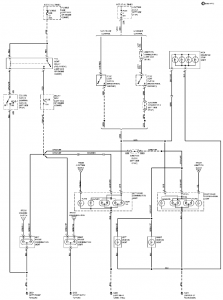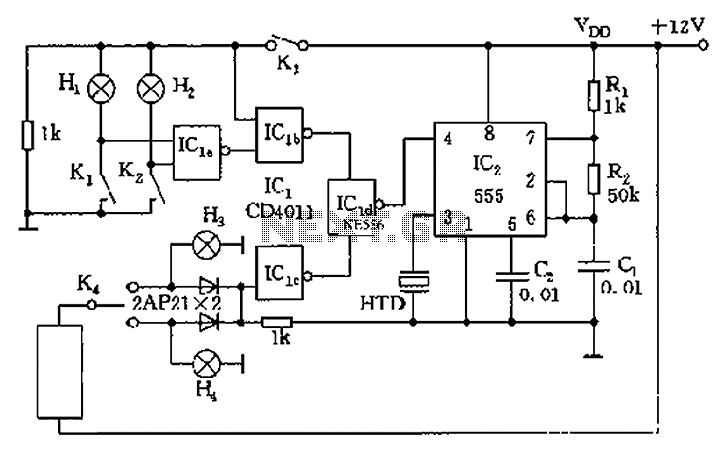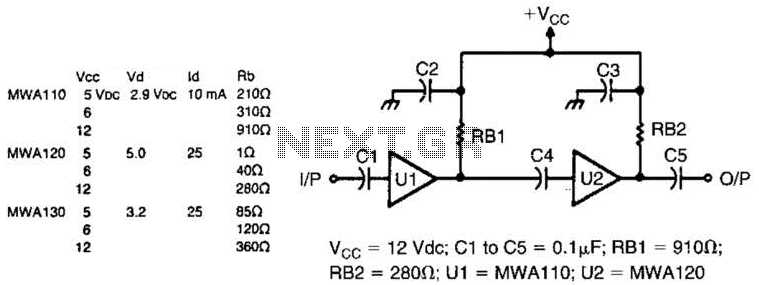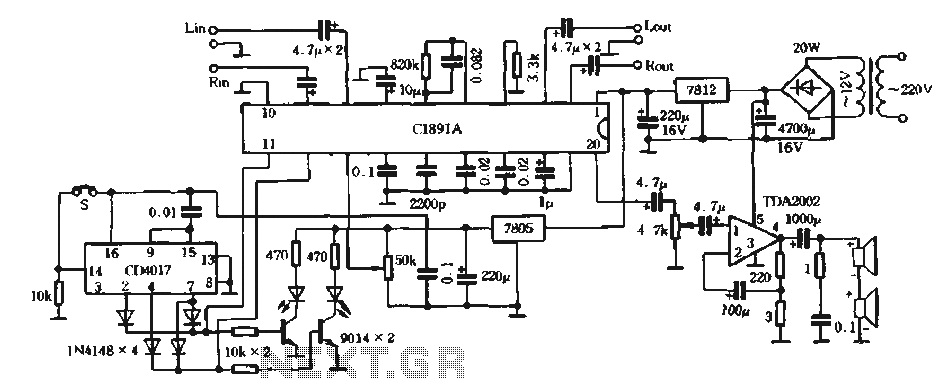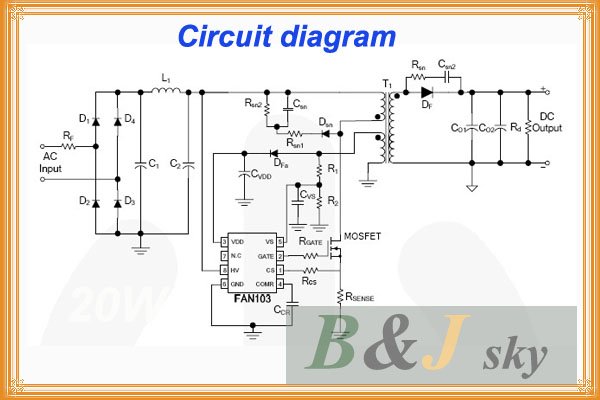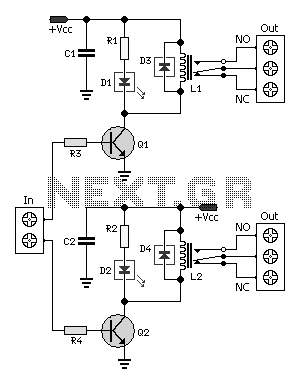
Metal locator circuit
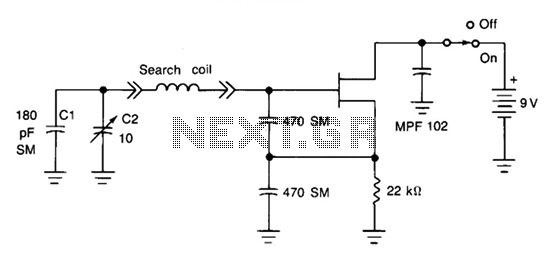
The search coil, CI and C2, form a tuned circuit for the oscillator, which is tuned near the center of the broadcast band. Tune a portable radio to a station near the middle of the band, then adjust C2 until a squeal is heard as the two signals mix to produce a beat (heterodyne) note. Metal near the search coil will detune the circuit slightly, changing the pitch of the squeal. The search coil consists of 20 turns of number 30 enameled wire, wound on a 6" x 8" wood or plastic form. It is affixed at the end of a 30" to 40" wooden or plastic pole and connected to the remainder of the metal detector circuit through a coaxial cable.
The described circuit utilizes a tuned oscillator configuration where the search coil, identified as CI, and a variable capacitor, C2, work together to form a resonant circuit. This circuit is designed to operate in the vicinity of the center frequency of the AM broadcast band, typically around 1 MHz to 1.5 MHz. The tuning process involves adjusting C2 while monitoring a portable radio that is set to a frequency within this range. When the tuning is correct, the interaction between the oscillator and the radio creates a heterodyne effect, producing an audible beat frequency or squeal.
The physical construction of the search coil is critical to its performance. The coil is made of 20 turns of number 30 enameled wire, which provides a good balance between inductance and resistance. The dimensions of the coil, wound on a 6" by 8" form, are chosen to optimize the inductance and sensitivity of the metal detector. The choice of a wooden or plastic form helps to minimize any unwanted interference that could affect the coil's performance.
The search coil is mounted on a pole that measures between 30 to 40 inches in length, allowing for ease of use and maneuverability while searching for metallic objects. The connection to the metal detector circuitry is made using a coaxial cable, which is essential for maintaining signal integrity and reducing noise from external sources. This configuration ensures that the signals generated by the search coil can be effectively transmitted to the rest of the metal detector system, enabling accurate detection of metallic objects based on changes in the pitch of the heterodyne note when nearby metal alters the circuit's tuning.The search coil, CI and C2 form a tuned circuit for the oscillator which is tuned near the center of the broadcast band. Tune a portable radio to a station near the middle of the band, then tune C2 until a squeal is heard as the two signals mix to produce a beat (heterodyne) note.
Metal near the search coil will detune the circuit slightly, changing the pitch of the squeal. The search coil is 20 turns of number 30 enameled wire, wound on a 6" ? 8" wood or plastic form. It is affixed at the end of a 30" to 40" wooden or plastic pole, and connected to the remainder of the metal detector circuit through a coaxial cable.
The described circuit utilizes a tuned oscillator configuration where the search coil, identified as CI, and a variable capacitor, C2, work together to form a resonant circuit. This circuit is designed to operate in the vicinity of the center frequency of the AM broadcast band, typically around 1 MHz to 1.5 MHz. The tuning process involves adjusting C2 while monitoring a portable radio that is set to a frequency within this range. When the tuning is correct, the interaction between the oscillator and the radio creates a heterodyne effect, producing an audible beat frequency or squeal.
The physical construction of the search coil is critical to its performance. The coil is made of 20 turns of number 30 enameled wire, which provides a good balance between inductance and resistance. The dimensions of the coil, wound on a 6" by 8" form, are chosen to optimize the inductance and sensitivity of the metal detector. The choice of a wooden or plastic form helps to minimize any unwanted interference that could affect the coil's performance.
The search coil is mounted on a pole that measures between 30 to 40 inches in length, allowing for ease of use and maneuverability while searching for metallic objects. The connection to the metal detector circuitry is made using a coaxial cable, which is essential for maintaining signal integrity and reducing noise from external sources. This configuration ensures that the signals generated by the search coil can be effectively transmitted to the rest of the metal detector system, enabling accurate detection of metallic objects based on changes in the pitch of the heterodyne note when nearby metal alters the circuit's tuning.The search coil, CI and C2 form a tuned circuit for the oscillator which is tuned near the center of the broadcast band. Tune a portable radio to a station near the middle of the band, then tune C2 until a squeal is heard as the two signals mix to produce a beat (heterodyne) note.
Metal near the search coil will detune the circuit slightly, changing the pitch of the squeal. The search coil is 20 turns of number 30 enameled wire, wound on a 6" ? 8" wood or plastic form. It is affixed at the end of a 30" to 40" wooden or plastic pole, and connected to the remainder of the metal detector circuit through a coaxial cable.
